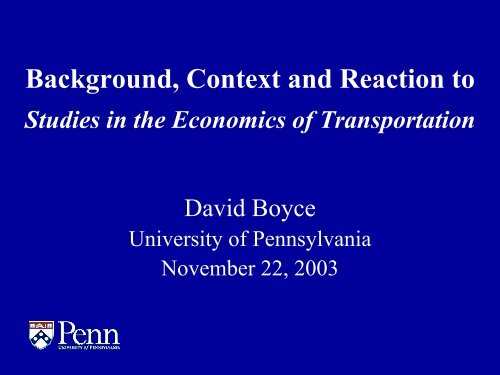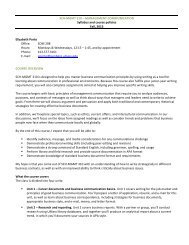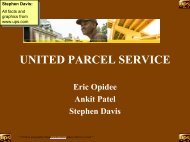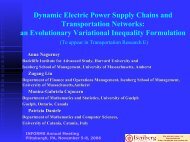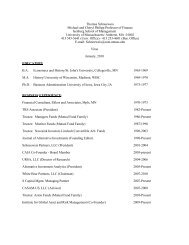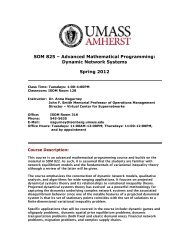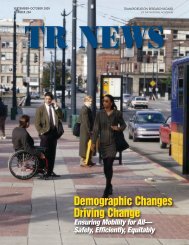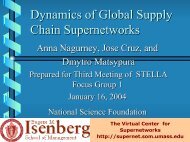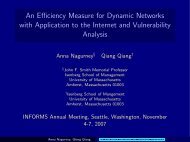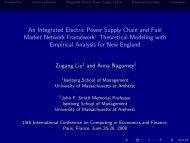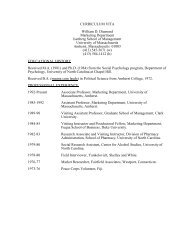Background, Context and Reaction to Studies in the Economics of ...
Background, Context and Reaction to Studies in the Economics of ...
Background, Context and Reaction to Studies in the Economics of ...
Create successful ePaper yourself
Turn your PDF publications into a flip-book with our unique Google optimized e-Paper software.
<strong>Background</strong>, <strong>Context</strong> <strong>and</strong> <strong>Reaction</strong> <strong>to</strong><br />
<strong>Studies</strong> <strong>in</strong> <strong>the</strong> <strong>Economics</strong> <strong>of</strong> Transportation<br />
David Boyce<br />
University <strong>of</strong> Pennsylvania<br />
November 22, 2003
Overview<br />
• Orig<strong>in</strong>s <strong>and</strong> Publication <strong>of</strong>:<br />
<strong>Studies</strong> <strong>in</strong> <strong>the</strong> <strong>Economics</strong> <strong>of</strong> Transportation<br />
• Earlier, Concurrent <strong>and</strong> Subsequent Research<br />
• Forecast<strong>in</strong>g Urban Travel for Plann<strong>in</strong>g <strong>and</strong><br />
Policy Mak<strong>in</strong>g<br />
• Summary <strong>and</strong> Lessons Learned
Orig<strong>in</strong>s <strong>and</strong> Publication<br />
• Contributions <strong>of</strong> Beckmann, McGuire <strong>and</strong><br />
W<strong>in</strong>sten (BMW)<br />
• Publication His<strong>to</strong>ry<br />
• Book Reviews
Contributions <strong>of</strong> BMW<br />
Project <strong>in</strong>itiation 1951<br />
Work<strong>in</strong>g Papers 1952<br />
Discussion Paper 1953<br />
Completed equilibrium <strong>and</strong> efficiency formulations 1954<br />
Publication <strong>of</strong> SET by R<strong>and</strong> 1955<br />
Publication <strong>of</strong> SET by Yale University Press 1956<br />
Publication <strong>of</strong> SET <strong>in</strong> Spanish<br />
1959<br />
Beckmann, paper Traffic Quarterly<br />
1967<br />
Recognition at Montréal Symposium 1974
Contributions <strong>of</strong> BMW<br />
• Discussion Paper R<strong>and</strong>-P-437, 1953, remarkable for its<br />
<strong>in</strong>sights regard<strong>in</strong>g urban transportation systems; submitted<br />
<strong>to</strong> Traffic Quarterly <strong>and</strong> rejected.<br />
• Formulation <strong>and</strong> analysis <strong>of</strong> an optimization problem<br />
relat<strong>in</strong>g variable O-D flows <strong>to</strong> user-equilibrium route flows<br />
over a network, 1951-1954. One start<strong>in</strong>g po<strong>in</strong>t was Knight<br />
(1924); ano<strong>the</strong>r was Kuhn <strong>and</strong> Tucker (1951).<br />
• Formulation <strong>and</strong> analysis <strong>of</strong> a related problem with systemoptimal<br />
route flows based on marg<strong>in</strong>al costs; applied <strong>to</strong> <strong>the</strong><br />
study <strong>of</strong> road pric<strong>in</strong>g.<br />
• Publication <strong>of</strong> <strong>Studies</strong> <strong>in</strong> <strong>the</strong> <strong>Economics</strong> <strong>of</strong> Transportation<br />
(SET) as R<strong>and</strong>-RM 1488, May 1955.<br />
• Publication <strong>of</strong> SET by Yale <strong>and</strong> Oxford University Presses<br />
<strong>in</strong> 1956, followed by a Spanish version <strong>in</strong> 1959.
• M. J. Beckmann, On Optimal Tolls for Highways, Tunnels<br />
<strong>and</strong> Bridges, Vehicular Traffic Science, Proceed<strong>in</strong>gs <strong>of</strong> <strong>the</strong><br />
Third International Symposium, 1965, Herman et al., eds.,<br />
Elsevier, 1967; cited Johnson, Walters <strong>and</strong> Wardrop, as<br />
well as BMW.<br />
• M. J. Beckmann, On <strong>the</strong> Theory <strong>of</strong> Traffic Flow <strong>in</strong><br />
Networks, Traffic Quarterly, 21 (1967); a synopsis <strong>of</strong> <strong>the</strong><br />
ma<strong>in</strong> results <strong>of</strong> Part I <strong>of</strong> SET, <strong>and</strong> a review <strong>of</strong> related<br />
developments, <strong>in</strong>clud<strong>in</strong>g Wardrop, Prager, Almond,<br />
Charnes-Cooper, <strong>and</strong> Walters.<br />
• Recognition <strong>of</strong> <strong>the</strong> contributions <strong>of</strong> BMW at <strong>the</strong><br />
International Symposium on Traffic Equilibrium Methods<br />
held at <strong>the</strong> Université de Montréal, November, 1974<br />
(Florian, Traffic Equilibrium Methods, Spr<strong>in</strong>ger, 1976).
Publication His<strong>to</strong>ry <strong>of</strong> SET<br />
• R<strong>and</strong> Corporation issued SET <strong>in</strong> 1955 as RM-1488-PR; it<br />
has recently been listed as a R<strong>and</strong> Classic; <strong>the</strong> 359 page<br />
monograph can be downloaded at no charge at:<br />
http://www.r<strong>and</strong>.org/publications/RM/RM1488.pdf<br />
• Yale University Press made three pr<strong>in</strong>t<strong>in</strong>gs <strong>of</strong> SET, 1956-<br />
1959; <strong>the</strong> number <strong>of</strong> copies is unknown; <strong>the</strong> price was $4.<br />
The book will soon be listed on <strong>the</strong> Cowles Foundation<br />
website http://cowles.econ.yale.edu/.<br />
• Aguilar, Madrid, published Economía del Transporte, 1959.<br />
• SET was <strong>of</strong>fered by University Micr<strong>of</strong>ilms <strong>in</strong> <strong>the</strong> 1960s, <strong>and</strong><br />
can be purchased for $79.40 (pr<strong>in</strong>t) or $39.70 (micr<strong>of</strong>ilm).<br />
• WorldCat List <strong>of</strong> Records shows 356 libraries currently hold<br />
<strong>the</strong> Yale University Press edition <strong>of</strong> SET, 13 libraries hold<br />
<strong>the</strong> R<strong>and</strong> edition, <strong>and</strong> six libraries hold <strong>the</strong> Spanish edition.
Summary <strong>of</strong> Book Reviews<br />
• Operational Research Quarterly, 7 (1956), by D. J. R.<br />
• American Economic Review, 46 (1956): book notice only.<br />
• Wall Street Journal, January 2, 1957, p. 8, column 6: “.. this<br />
is a ‘heavy’ <strong>the</strong>oretical work by a group <strong>of</strong> economists<br />
search<strong>in</strong>g for <strong>the</strong> optimum efficiency <strong>of</strong> highway systems.”<br />
• The Economic Journal, 67 (1957) by R. J. Smeed<br />
• Quarterly J. <strong>of</strong> Applied Math., 14 (1957) by W. Prager<br />
• Econometrica, 26 (1958) by R. M. Thrall<br />
• KYKLOS, 11 (1958) by C. Ponsard<br />
• Operations Research 7 (1959) by G. D. Camp<br />
• Journal <strong>of</strong> Political Economy, 67 (1959) by E. Mansfield<br />
• Among n<strong>in</strong>e reviews published, no reviewer identified <strong>the</strong><br />
significance <strong>of</strong> <strong>the</strong> formulation achieved <strong>in</strong> Part I, <strong>and</strong> none<br />
l<strong>in</strong>ked BMW’s formulation <strong>to</strong> <strong>the</strong> need <strong>to</strong> forecast travel for<br />
urban transportation plann<strong>in</strong>g.
Details <strong>of</strong> Book Reviews<br />
• Operational Research Quarterly, 7 (1956), by D. J. R.:<br />
“..probably <strong>the</strong> most important contribution, Ch. 4 discusses<br />
efficiency <strong>and</strong> considers how far <strong>the</strong> <strong>in</strong>dividual road user,<br />
left <strong>to</strong> his own free decision, will make <strong>the</strong> most efficient<br />
use <strong>of</strong> a given road network. .. if any criticism can be made,<br />
it is that <strong>the</strong> work on highway economics is <strong>to</strong>o ambitious.<br />
The authors make few simplify<strong>in</strong>g assumptions … <strong>and</strong> <strong>the</strong>y<br />
f<strong>in</strong>d it difficult <strong>to</strong> produce conclusions.”<br />
• American Economic Review, 46 (1956): a notice, no review.<br />
• Wall Street Journal, January 2, 1957, p. 8, column 6:<br />
“Sponsored by <strong>the</strong> Cowles Commission, this is a ‘heavy’<br />
<strong>the</strong>oretical work by a group <strong>of</strong> economists search<strong>in</strong>g for <strong>the</strong><br />
optimum efficiency <strong>of</strong> railroad <strong>and</strong> highway systems. In <strong>the</strong><br />
chapters on highways, <strong>the</strong> authors analyze <strong>in</strong>tersection <strong>and</strong><br />
road capacity, s<strong>to</strong>p-sign <strong>and</strong> traffic light delays, <strong>to</strong>lls, <strong>and</strong><br />
<strong>the</strong> costs <strong>and</strong> dem<strong>and</strong>s for highway use.”
• The Economic Journal, 67 (1957) by R. J. Smeed: .. “<strong>the</strong><br />
selection by drivers <strong>of</strong> routes that m<strong>in</strong>imize <strong>the</strong>ir own<br />
<strong>in</strong>dividual costs does not result <strong>in</strong> <strong>the</strong> division <strong>of</strong> traffic<br />
between alternative routes which m<strong>in</strong>imizes <strong>the</strong> <strong>to</strong>tal costs<br />
<strong>in</strong>curred by road users. .. it is refresh<strong>in</strong>g <strong>to</strong> read a book that<br />
attempts <strong>to</strong> tackle <strong>the</strong> subject <strong>of</strong> road transport <strong>in</strong> a<br />
comprehensive <strong>and</strong> fundamental way.” (Smeed’s review is<br />
by far <strong>the</strong> longest <strong>and</strong> most thoughtful.)<br />
• Quarterly Journal <strong>of</strong> Applied Ma<strong>the</strong>matics, 14 (1957) by W.<br />
Prager: “This reviewer found <strong>the</strong> book extremely<br />
stimulat<strong>in</strong>g; his only compla<strong>in</strong>t is that <strong>the</strong> analysis is almost<br />
exclusively concerned with static situations.”<br />
• Econometrica, 26 (1958) by R. M. Thrall: “useful as an<br />
example <strong>of</strong> ‘operations research;’ good illustrative material;<br />
welcome addition <strong>to</strong> <strong>the</strong> literature.”
• KYKLOS, 11 (1958) by C. Ponsard, who was an em<strong>in</strong>ent<br />
French spatial economist: “A model <strong>of</strong> <strong>the</strong> whole ensemble<br />
appears premature <strong>to</strong> <strong>the</strong> authors. .. <strong>the</strong> <strong>Studies</strong> expose<br />
diverse ramifications <strong>in</strong> a stream <strong>of</strong> thought which has been<br />
l<strong>in</strong>ear up <strong>to</strong> now. The enrichment <strong>of</strong> knowledge <strong>in</strong> this<br />
doma<strong>in</strong> is at this price.”<br />
• Operations Research 7 (1959) by G. D. Camp: Part I<br />
“furnishes a clear picture <strong>of</strong> a highway system as a servomechanism<br />
with complex feedback <strong>in</strong>teractions among its<br />
parts, activated by <strong>the</strong> behavior <strong>of</strong> many drivers. Strong on<br />
concept <strong>and</strong> <strong>the</strong>ory but very weak on data, … because <strong>the</strong>y<br />
are not available. .. a must <strong>in</strong> <strong>the</strong> library <strong>of</strong> any operations<br />
researcher <strong>in</strong>terested <strong>in</strong> highway transportation.”<br />
• Journal <strong>of</strong> Political Economy, 67 (1959) by E. Mansfield:<br />
“<strong>the</strong> concept <strong>of</strong> dem<strong>and</strong> is <strong>in</strong>troduced, <strong>the</strong> existence <strong>and</strong><br />
stability <strong>of</strong> an equilibrium <strong>in</strong> <strong>the</strong> system are discussed, <strong>and</strong><br />
efficiency conditions are determ<strong>in</strong>ed (us<strong>in</strong>g <strong>the</strong> Kuhn-<br />
Tucker <strong>the</strong>orem). Highly recommended for economists<br />
<strong>in</strong>terested <strong>in</strong> <strong>the</strong> analysis <strong>of</strong> transportation systems.”
• Journal <strong>of</strong> Bus<strong>in</strong>ess, 32 (1959) by S. P. Sobotka: “The<br />
analysis <strong>of</strong> <strong>the</strong> difference between private <strong>and</strong> social costs is<br />
particularly valuable, but .. lack <strong>of</strong> concern with long-run<br />
problems tends <strong>to</strong> make <strong>the</strong> result<strong>in</strong>g conclusions ra<strong>the</strong>r<br />
empty.”<br />
• Al<strong>to</strong>ge<strong>the</strong>r, n<strong>in</strong>e reviews were published; none <strong>of</strong> <strong>the</strong><br />
reviewers identified <strong>the</strong> significance <strong>of</strong> <strong>the</strong> formulation<br />
achieved <strong>in</strong> Part I. Moreover, none l<strong>in</strong>ked BMW’s<br />
formulation <strong>to</strong> <strong>the</strong> emerg<strong>in</strong>g need <strong>to</strong> forecast travel for<br />
plann<strong>in</strong>g urban transportation systems.<br />
• Bart McGuire <strong>to</strong> his co-authors on Mar. 18, year unknown:<br />
“Here are copies <strong>of</strong> <strong>the</strong> reviews <strong>of</strong> our Chicago book.<br />
I th<strong>in</strong>k <strong>the</strong>y’re pretty enterta<strong>in</strong><strong>in</strong>g, don’t you?”
Earlier, Concurrent <strong>and</strong><br />
Subsequent Research<br />
• Traffic Assignment Problem (TAP) Preced<strong>in</strong>g <strong>and</strong><br />
Concurrent with BMW<br />
• TAP with Fixed OD Flows Independent <strong>of</strong> BMW<br />
• TAP with Fixed OD Flows Partially Based on BMW<br />
• TAP with Variable OD Flows Follow<strong>in</strong>g <strong>and</strong> Based<br />
on BMW
Traffic Assignment Problem<br />
Preced<strong>in</strong>g <strong>and</strong> Concurrent<br />
Knight 1924<br />
with BMW<br />
Duff<strong>in</strong> 1947<br />
Nash<br />
Wardrop<br />
Prager<br />
1951<br />
1952<br />
1954<br />
1956
Traffic Assignment Problem<br />
Preced<strong>in</strong>g <strong>and</strong> Concurrent with BMW<br />
• F. H. Knight, Quarterly Journal <strong>of</strong> <strong>Economics</strong> 38 (1924);<br />
cited by BMW.<br />
• R. J. Duff<strong>in</strong>, Nonl<strong>in</strong>ear Networks II, Bullet<strong>in</strong> AMS 53 (1947)<br />
formulated a related problem for electrical networks; not<br />
cited by BMW; Duff<strong>in</strong> was one <strong>of</strong> <strong>the</strong> crea<strong>to</strong>rs <strong>of</strong> geometric<br />
programm<strong>in</strong>g, among his many accomplishments.<br />
• J. Nash, Non-cooperative Games, Annals <strong>of</strong> Ma<strong>the</strong>matics<br />
54 (1951); not cited by BMW.<br />
• J. G. Wardrop, Proceed<strong>in</strong>gs ICE (1952); cited by BMW,<br />
but not for his pr<strong>in</strong>ciples <strong>of</strong> route choice.<br />
• W. Prager, Problems <strong>of</strong> Traffic <strong>and</strong> Transportation,<br />
Proceed<strong>in</strong>gs <strong>of</strong> Symposium on OR … (1954); <strong>in</strong>formal<br />
discussion <strong>of</strong> user-equilibrium problem; cited Wardrop.
Traffic Assignment Problem<br />
Independent <strong>of</strong> BMW<br />
1956<br />
1958 Charnes & Cooper<br />
1959 Charnes & Cooper<br />
1962<br />
Jorgensen<br />
1965 Overgaard<br />
1966 Jewell
TAP with Fixed OD Flows<br />
Independent <strong>of</strong> BMW<br />
• A. Charnes <strong>and</strong> W. Cooper, Extremal Pr<strong>in</strong>ciples for<br />
Simulat<strong>in</strong>g Traffic Flow <strong>in</strong> a Network, Proceed<strong>in</strong>gs <strong>of</strong> <strong>the</strong><br />
N.A.S. (1958); cited Duff<strong>in</strong>, Nash, Prager <strong>and</strong> Wardrop, but<br />
not BMW; clear underst<strong>and</strong><strong>in</strong>g <strong>of</strong> assignment from a<br />
practitioners’ po<strong>in</strong>t <strong>of</strong> view.<br />
• A. Charnes <strong>and</strong> W. Cooper, Multicopy Traffic Network<br />
Models, Theory <strong>of</strong> Traffic Flow, Proceed<strong>in</strong>gs <strong>of</strong> <strong>the</strong> First<br />
Symposium, 1959, R. Herman, ed., Elsevier, 1961. Clear<br />
statement <strong>of</strong> pr<strong>in</strong>ciples <strong>of</strong> user-equilibrium <strong>and</strong> formulation<br />
<strong>of</strong> <strong>the</strong> problem; a <strong>to</strong>y problem with 11 OD pairs, 22 nodes<br />
<strong>and</strong> 54 l<strong>in</strong>ks was solved us<strong>in</strong>g piecewise l<strong>in</strong>earization.<br />
Cited Duff<strong>in</strong>, Nash, Prager <strong>and</strong> Wardrop, as well as <strong>the</strong>ir<br />
own 1958 paper, but not BMW.
• N. O. Jorgensen, Some Aspects <strong>of</strong> <strong>the</strong> Urban Traffic<br />
Assignment Problem, M.S. <strong>the</strong>sis, U.C. Berkeley (1962);<br />
<strong>in</strong>dependent formulation <strong>and</strong> analysis <strong>of</strong> TAP. Cited<br />
Wardrop, <strong>and</strong> Charnes-Cooper, 1961, but not BMW.<br />
• K. R. Overgaard, Test<strong>in</strong>g a Traffic Assignment Algorithm,<br />
Vehicular Traffic Science, Third Symposium, 1965, Herman<br />
et al., eds., Elsevier, 1967; presented a formulation <strong>of</strong> TAP<br />
based on Jorgensen <strong>and</strong> a heuristic method <strong>of</strong> assign<strong>in</strong>g<br />
traffic. Smock’s heuristic method seems <strong>to</strong> be <strong>the</strong> basis <strong>of</strong><br />
<strong>the</strong> study. Cited Irw<strong>in</strong>-von Cube, Jorgensen, Smock <strong>and</strong><br />
Wardrop.<br />
• W. S. Jewell, Models for Traffic Assignment, SEMA, Paris<br />
(1966), TR 1 (1967); formulated UE problem for a s<strong>in</strong>gle<br />
OD pair <strong>and</strong> network; did not cite BMW or Jorgensen.
Traffic Assignment Problem<br />
Based on BMW<br />
Fixed<br />
OD Flows<br />
1956<br />
1961<br />
Variable<br />
OD Flows<br />
Walters<br />
1964<br />
Almond 1965<br />
1967<br />
Dafermos 1968<br />
Bruynooghe et al. 1969<br />
Netter 1971<br />
Leventhal /LeBlanc 1973<br />
Nguyen 1974<br />
1975<br />
1977<br />
Johnson<br />
Toml<strong>in</strong><br />
Murchl<strong>and</strong><br />
Evans<br />
Potts & Oliver<br />
Florian et al.<br />
Erl<strong>and</strong>er
TAP with Fixed OD Flows<br />
Partially Based on BMW<br />
• J. Almond, Traffic Assignment with Flow-Dependent<br />
Travel Times, Vehicular Traffic Science, Proceed<strong>in</strong>gs <strong>of</strong><br />
<strong>the</strong> Third Symposium, 1965, Herman et al., eds., Elsevier,<br />
1967; described solution methods for TAP, but did not give<br />
a formulation. Cited Wardrop <strong>and</strong> BMW.<br />
• S. Dafermos, Traffic Assignment <strong>and</strong> Resource Allocation<br />
<strong>in</strong> Transportation Networks, Ph.D. <strong>the</strong>sis (1968) <strong>and</strong> paper<br />
with F. T. Sparrow, J. <strong>of</strong> Research, NBS (1969); cited<br />
BMW, Jorgensen, Almond, Beckmann (1967); start<strong>in</strong>g<br />
po<strong>in</strong>t appears <strong>to</strong> be Jorgensen’s <strong>the</strong>sis.<br />
• M. Bruynooghe, A. Gibert <strong>and</strong> M. Sakarovitch (BGS), A<br />
Traffic Assignment Method (<strong>in</strong> French), Beiträge zur<br />
Theorie des Verkehrsflusses (1969); clear statement <strong>of</strong><br />
optimality conditions, but no objective function; described<br />
two algorithms; cited Jorgensen, Jewell <strong>and</strong> BMW.
• M. Netter, Traffic Assignment <strong>and</strong> Social Marg<strong>in</strong>al Cost<br />
Pric<strong>in</strong>g, ISTTT (1971) <strong>and</strong> TR 6 (1972); properties <strong>of</strong> userequilibrium<br />
<strong>and</strong> system-optimal solutions; cited Wardrop,<br />
BMW, BGS, Dafermos, etc.<br />
• T. Leventhal, G. Nemhauser <strong>and</strong> L. Trotter, Jr., A Column<br />
Generation Method for TAP, TS 7 (1973); extended<br />
Dafermos’s algorithm so that generation <strong>of</strong> all routes is not<br />
required; cited three papers by Dafermos, but not BMW.<br />
• L. J. LeBlanc, Approach <strong>to</strong> Equilibrium Traffic Assignment,<br />
part <strong>of</strong> Ph.D. <strong>the</strong>sis (1973); TR 9 (1975); formulated TAP<br />
<strong>and</strong> proposed algorithm based on Frank-Wolfe (1956); cited<br />
BMW, Charnes-Cooper, Dafermos, Jorgensen <strong>and</strong> Wardrop.<br />
• S. Nguyen, Unified Approach <strong>to</strong> Equilibrium Methods for<br />
Traffic Assignment, Ph.D. <strong>the</strong>sis, 1974; TS 8 (1974); Traffic<br />
Equilibrium Symposium, 1974 (1976); stated <strong>and</strong> tested<br />
three algorithms for solv<strong>in</strong>g TAP; cited BMW, BGS,<br />
Dafermos, Jewell, Jorgensen, etc.
TAP with Variable OD Flows<br />
Follow<strong>in</strong>g <strong>and</strong> Based on BMW<br />
• A. A. Walters, Theory <strong>and</strong> Measurement <strong>of</strong> Private <strong>and</strong><br />
Social Cost <strong>of</strong> Highway Congestion, Econometrica 29<br />
(1961); analysis <strong>of</strong> a s<strong>in</strong>gle route <strong>and</strong> OD pair, deferr<strong>in</strong>g <strong>to</strong><br />
BMW for network model; cited Knight, but not Wardrop.<br />
• M. B. Johnson, <strong>Economics</strong> <strong>of</strong> Road Congestion,<br />
Econometrica, 32 (1964); explored a simple model <strong>of</strong> road<br />
congestion for one l<strong>in</strong>k; cited BMW <strong>and</strong> Walters.<br />
• J. A. Toml<strong>in</strong>, Math. Programm<strong>in</strong>g Models for Traffic<br />
Network Problems, Ph.D. <strong>the</strong>sis, 1967, TS 5 (1971);<br />
formulated a comb<strong>in</strong>ed trip distribution <strong>and</strong> assignment<br />
model with fixed l<strong>in</strong>k costs <strong>and</strong> capacities; proposed an<br />
algorithm based on Dantzig-Wolfe decomposition; cited<br />
Charnes-Cooper, Jorgensen, Wardrop, but not BMW.
• J. D. Murchl<strong>and</strong>, Road Network Traffic Distribution <strong>in</strong><br />
Equilibrium, presented at Math. Methods <strong>in</strong> <strong>the</strong> Economic<br />
Sciences, 1969; first variable dem<strong>and</strong> formulation after<br />
BMW, <strong>in</strong>clud<strong>in</strong>g a proposed solution algorithm; cited<br />
Beckmann’s early papers, BGS, Prager <strong>and</strong> Wardrop.<br />
• S. P. Evans, Some Applications <strong>of</strong> Ma<strong>the</strong>matical<br />
Optimization Theory <strong>in</strong> Transport Plann<strong>in</strong>g, Ph.D. <strong>the</strong>sis<br />
(1973), TR 10 (1976); formulated a model comb<strong>in</strong><strong>in</strong>g trip<br />
distribution <strong>and</strong> assignment, proposed a partial l<strong>in</strong>earization<br />
solution algorithm <strong>and</strong> proved convergence; cited BMW,<br />
BGS, Florian, Jorgensen, Murchl<strong>and</strong>, Toml<strong>in</strong>, Wardrop, etc.<br />
• R. B. Potts <strong>and</strong> R. M. Oliver, Flows <strong>in</strong> Transportation<br />
Networks, Academic; considered <strong>the</strong> traffic assignment<br />
problem, but did not give a formulation, <strong>and</strong> <strong>the</strong>n described<br />
a comb<strong>in</strong>ed model for system-optimal route flows; cited<br />
BMW, Beckmann (1967) <strong>and</strong> Toml<strong>in</strong>.
• M. Florian <strong>and</strong> S. Nguyen, Comput<strong>in</strong>g Network<br />
Equilibrium with Elastic Dem<strong>and</strong>s, TS 8 (1974); proposed<br />
an algorithm for solv<strong>in</strong>g <strong>the</strong> model <strong>of</strong> BMW based on<br />
Benders decomposition; cited BMW, Murchl<strong>and</strong>, Dafermos.<br />
• M. Florian, S. Nguyen <strong>and</strong> J. Ferl<strong>and</strong>, Comb<strong>in</strong>ed<br />
Distribution-Assignment <strong>of</strong> Traffic, TS 9 (1975); applied<br />
Benders decomposition <strong>to</strong> <strong>the</strong> same problem with a<br />
doubly-constra<strong>in</strong>ed trip distribution model <strong>and</strong> userequilibrium<br />
assignment; cited BGS, Dafermos, Evans’s<br />
<strong>the</strong>sis, Murchl<strong>and</strong>, Potts-Oliver, but not BMW.<br />
• S. Erl<strong>and</strong>er, Accessibility, Entropy <strong>and</strong> <strong>the</strong> Distribution <strong>and</strong><br />
Assignment <strong>of</strong> Traffic, TR 11 (1977); new <strong>in</strong>terpretation <strong>of</strong><br />
<strong>the</strong> entropy function <strong>in</strong> <strong>the</strong> comb<strong>in</strong>ed model formulation;<br />
cited Florian et al., Potts-Oliver, <strong>and</strong> Toml<strong>in</strong>.
Efforts <strong>to</strong> Forecast Urban Travel<br />
for Plann<strong>in</strong>g <strong>and</strong> Policy Mak<strong>in</strong>g<br />
• Urban Transportation <strong>Studies</strong> Concurrent with<br />
Publication <strong>of</strong> SET<br />
• Early Practitioner Efforts <strong>to</strong> Solve TAP<br />
• Status <strong>of</strong> <strong>the</strong> Travel Forecast<strong>in</strong>g Field Today
Urban Transportation <strong>Studies</strong><br />
Concurrent with Publication <strong>of</strong> SET<br />
• The first urban transportation study <strong>to</strong>ok place <strong>in</strong> Detroit<br />
under <strong>the</strong> direction <strong>of</strong> J. Douglas Carroll, Jr.; <strong>in</strong>itially, an<br />
orig<strong>in</strong>-dest<strong>in</strong>ation desire l<strong>in</strong>e analysis was performed with<br />
no network analysis.<br />
• The first urban transportation study us<strong>in</strong>g models <strong>of</strong> orig<strong>in</strong>dest<strong>in</strong>ation<br />
<strong>and</strong> route flows (trip distribution <strong>and</strong> traffic<br />
assignment) was <strong>in</strong> Chicago, 1955-1962, also led by Carroll.<br />
The Chicago Area Transportation Study (CATS) <strong>in</strong>novated<br />
with respect <strong>to</strong> <strong>the</strong> formulation <strong>and</strong> application <strong>of</strong> an<br />
<strong>in</strong>terven<strong>in</strong>g opportunities model <strong>and</strong> <strong>the</strong> use <strong>of</strong> a tree-based<br />
algorithm <strong>to</strong> assign OD flows <strong>to</strong> shortest routes through <strong>the</strong><br />
road network.
• Carroll <strong>and</strong> his associates also <strong>in</strong>itiated <strong>the</strong> concept <strong>of</strong> <strong>the</strong><br />
sequential travel forecast<strong>in</strong>g procedure; as stated <strong>in</strong> an<br />
abstract for <strong>the</strong> January 1957 Highway Research Board<br />
Meet<strong>in</strong>g: “a cont<strong>in</strong>uous, <strong>in</strong>tegrated analysis <strong>and</strong> plann<strong>in</strong>g<br />
process consists <strong>of</strong> three major parts, each a considerable<br />
advance <strong>in</strong> itself:<br />
– Estimat<strong>in</strong>g traffic generation from l<strong>and</strong> use;<br />
– Predict<strong>in</strong>g future l<strong>in</strong>es <strong>of</strong> travel desire;<br />
– Predict<strong>in</strong>g flows on a transportation network.”<br />
Although mode choice is not <strong>in</strong>cluded, test<strong>in</strong>g <strong>of</strong> a mass<br />
transit facility is described.<br />
• Carroll was proactive <strong>in</strong> search<strong>in</strong>g for research <strong>in</strong>novations<br />
that could streng<strong>the</strong>n <strong>the</strong> computer-based analysis he<br />
envisaged, which led <strong>to</strong> <strong>the</strong> identification <strong>and</strong> application <strong>of</strong><br />
shortest route methods. Evidently, he was not aware <strong>of</strong> SET;<br />
moreover, it appears he <strong>and</strong> his associates did not grasp <strong>the</strong><br />
significance <strong>of</strong> Charnes’s formulation <strong>of</strong> TAP.
• Irw<strong>in</strong> <strong>and</strong> von Cube, Capacity Restra<strong>in</strong>t <strong>in</strong> Multi-Travel<br />
Mode Assignment Programs, Trip Characteristics <strong>and</strong><br />
Traffic Assignment, Bullet<strong>in</strong> 347, Highway Research Board,<br />
1962; described a sequential procedure <strong>in</strong>clud<strong>in</strong>g<br />
assignment <strong>to</strong> l<strong>in</strong>ks whose costs <strong>in</strong>crease with flow, <strong>and</strong> a<br />
“feedback procedure repeated until equilibrium is reached.”<br />
Cited BMW.<br />
• The Bureau <strong>of</strong> Public Roads likewise adopted <strong>the</strong> sequential<br />
approach <strong>in</strong> its consideration <strong>and</strong> dissem<strong>in</strong>ation <strong>of</strong> travel<br />
forecast<strong>in</strong>g procedures follow<strong>in</strong>g <strong>the</strong> Highway Act <strong>of</strong> 1962,<br />
which required preparation <strong>of</strong> transportation plans <strong>to</strong> qualify<br />
for federal aid for road construction.
Early Practitioner Efforts <strong>to</strong> Solve TAP<br />
• Early analyses <strong>of</strong> <strong>the</strong> impact <strong>of</strong> major road improvements<br />
applied an empirical diversion curve approach, which<br />
sought <strong>to</strong> reallocate traffic on <strong>the</strong> basis <strong>of</strong> time sav<strong>in</strong>gs.<br />
• As larger computers <strong>and</strong> shortest route methods became<br />
available <strong>in</strong> <strong>the</strong> U.S. <strong>in</strong> <strong>the</strong> late 1950s, solv<strong>in</strong>g <strong>the</strong> Traffic<br />
Assignment Problem was viewed as a procedure for<br />
“load<strong>in</strong>g” orig<strong>in</strong>-dest<strong>in</strong>ation flows on<strong>to</strong> shortest routes <strong>of</strong><br />
<strong>the</strong> road network<br />
• Wardrop’s pr<strong>in</strong>ciples <strong>of</strong> route choice were unknown <strong>to</strong><br />
practitioners <strong>in</strong> <strong>the</strong> U.S. Likewise, <strong>the</strong> route choice<br />
formulations <strong>of</strong> Beckmann, Prager, <strong>and</strong> Charnes-Cooper<br />
were generally unknown <strong>to</strong> practitioners.
• Iterative, heuristic schemes known as capacity-restra<strong>in</strong>ed<br />
assignment <strong>to</strong> solve TAP were proposed <strong>and</strong> compared; as<br />
no measure <strong>of</strong> convergence was available, <strong>and</strong> ma<strong>the</strong>matical<br />
formulations were not recognized as pert<strong>in</strong>ent, <strong>the</strong> results<br />
were crude <strong>and</strong> difficult <strong>to</strong> <strong>in</strong>terpret. An example is given by<br />
Smock (1963).<br />
• Formulations <strong>and</strong> convergent solution algorithms were<br />
<strong>in</strong>troduced <strong>to</strong> practitioners dur<strong>in</strong>g <strong>the</strong> 1970s by Florian, Dial,<br />
<strong>and</strong> Eash-Janson-Boyce; <strong>the</strong>se methods were superior <strong>and</strong><br />
quickly became <strong>the</strong> state <strong>of</strong> practice, although few iterations<br />
were performed <strong>in</strong>itially.<br />
• Ironically, <strong>the</strong> method that provided <strong>the</strong> basis for <strong>the</strong>se<br />
convergent algorithms was published by Frank <strong>and</strong> Wolfe<br />
<strong>in</strong> 1956, <strong>the</strong> same year as <strong>the</strong> publication <strong>of</strong> SET.
Status <strong>of</strong> <strong>the</strong> Urban Travel<br />
Forecast<strong>in</strong>g Field Today<br />
• From its beg<strong>in</strong>n<strong>in</strong>gs <strong>in</strong> <strong>the</strong> 1950s, <strong>the</strong> sequential procedure<br />
became <strong>the</strong> dom<strong>in</strong>ant paradigm for travel forecast<strong>in</strong>g<br />
throughout <strong>the</strong> world; it is widely accepted <strong>in</strong> nearly all<br />
academic textbooks <strong>and</strong> practitioner-oriented papers <strong>and</strong><br />
manuals.<br />
• Some 40 years after its emergence, calls for solv<strong>in</strong>g <strong>the</strong><br />
sequential procedure with “feedback,” <strong>to</strong> reduce <strong>the</strong><br />
<strong>in</strong>consistencies between travel costs, on which orig<strong>in</strong>dest<strong>in</strong>ation-mode<br />
flows are based, <strong>and</strong> user-equilibrium<br />
route costs result<strong>in</strong>g from assignment <strong>of</strong> those flows, began<br />
<strong>to</strong> be expressed <strong>in</strong> court cases <strong>and</strong> legislation. Practitioners<br />
were ill-prepared <strong>to</strong> respond, still be<strong>in</strong>g unaware <strong>of</strong> <strong>the</strong><br />
formulation <strong>of</strong> <strong>the</strong> model orig<strong>in</strong>ally proposed by BMW.
• From 1975 onwards, researchers have studied <strong>and</strong><br />
implemented models based on <strong>the</strong> formulation <strong>of</strong> BMW <strong>and</strong><br />
<strong>the</strong> solution algorithm <strong>of</strong> Evans. Among <strong>the</strong>se are: Boyce<br />
<strong>and</strong> his students; de Cea <strong>and</strong> Fern<strong>and</strong>ez; Horowitz; LeBlanc<br />
<strong>and</strong> his students; Lam <strong>and</strong> Huang; Lundqvist; Magnanti <strong>and</strong><br />
his students; Nagurney <strong>and</strong> her students; Oppenheim,<br />
Powell <strong>and</strong> Sheffi. Patriksson (1994) syn<strong>the</strong>sized <strong>the</strong><br />
extensive literature on <strong>the</strong> <strong>to</strong>pic <strong>and</strong> <strong>the</strong> ma<strong>the</strong>matical basis<br />
for formulations <strong>and</strong> solution algorithms.<br />
• Bar-Gera (1999) devised an Orig<strong>in</strong>-Based Assignment<br />
algorithm <strong>to</strong> solve TAP <strong>to</strong> f<strong>in</strong>e convergence for large<br />
networks with reasonable comput<strong>in</strong>g effort; he has s<strong>in</strong>ce<br />
comb<strong>in</strong>ed OBA with two O-D-mode flow models.<br />
• ESTRAUS, a newer s<strong>of</strong>tware system, solves directly<br />
comb<strong>in</strong>ed models <strong>of</strong> O-D, mode <strong>and</strong> route choice on<br />
congested road <strong>and</strong> transit networks; o<strong>the</strong>r systems<br />
(EMME/2, TransCAD, VISUM) can be programmed <strong>to</strong><br />
solve comb<strong>in</strong>ed models, but with considerable effort.
? Travel forecast<strong>in</strong>g practice is slowly mov<strong>in</strong>g from 50 years<br />
<strong>of</strong> empirically-based models <strong>and</strong> rough heuristics<br />
implemented on early computers, us<strong>in</strong>g <strong>in</strong>teger arithmetic<br />
<strong>and</strong> lack<strong>in</strong>g <strong>in</strong> rigorous solution criteria, <strong>to</strong> well-formulated<br />
models <strong>and</strong> efficient solution algorithms able <strong>to</strong> achieve<br />
precise answers that are required for compar<strong>in</strong>g plann<strong>in</strong>g<br />
<strong>and</strong> policy alternatives.<br />
? The transition is pa<strong>in</strong>ful for all concerned, but also excit<strong>in</strong>g<br />
for those who have devoted <strong>the</strong>ir careers <strong>to</strong> this relatively<br />
esoteric pursuit. Cont<strong>in</strong>ued progress will require much<br />
patience <strong>and</strong> effort.
Summary <strong>and</strong> Lessons Learned<br />
• A brilliant <strong>the</strong>oretical formulation <strong>of</strong> urban travel models<br />
was achieved <strong>in</strong> <strong>the</strong> early 1950s; its significance was not<br />
fully appreciated even by its authors, <strong>and</strong> not unders<strong>to</strong>od<br />
by o<strong>the</strong>rs for nearly 20 years.<br />
• Related <strong>and</strong> partial formulations were proposed by several<br />
o<strong>the</strong>rs dur<strong>in</strong>g <strong>the</strong> same period, but poor scientific<br />
communication restricted <strong>the</strong>ir assimilation. In particular,<br />
until 1967 <strong>the</strong>re were no scientific journals directly serv<strong>in</strong>g<br />
this field <strong>of</strong> research.<br />
• Transportation planners, unaware <strong>of</strong> <strong>the</strong>se developments,<br />
sought <strong>to</strong> make travel forecasts by empirical <strong>and</strong> heuristic<br />
methods, sometimes with strik<strong>in</strong>g similarities <strong>to</strong> convergent<br />
solution methods proposed somewhat later.
• Solution algorithms, model implementation, parameter<br />
estimation, validation <strong>and</strong> useful s<strong>of</strong>tware systems have<br />
slowly emerged, provid<strong>in</strong>g a more rigorous basis for<br />
solution <strong>of</strong> practical plann<strong>in</strong>g problems.<br />
• This s<strong>to</strong>ry illustrates <strong>the</strong> chaotic path that scientific research<br />
<strong>of</strong>ten follows <strong>in</strong> <strong>the</strong> evolution <strong>of</strong> a field. Interdiscipl<strong>in</strong>ary <strong>in</strong><br />
nature, this field has probably experienced more chaos than<br />
o<strong>the</strong>rs. Hopefully, as <strong>the</strong> field matures dur<strong>in</strong>g <strong>the</strong> next 50<br />
years, through <strong>the</strong> publication <strong>of</strong> reviews, textbooks, <strong>and</strong><br />
improved s<strong>of</strong>tware <strong>and</strong> tra<strong>in</strong><strong>in</strong>g for practitioners, <strong>the</strong><br />
promise <strong>of</strong> young, <strong>in</strong>sightful researchers <strong>and</strong> visionary<br />
practitioners dur<strong>in</strong>g <strong>the</strong> first 50 years will f<strong>in</strong>ally be<br />
realized.


